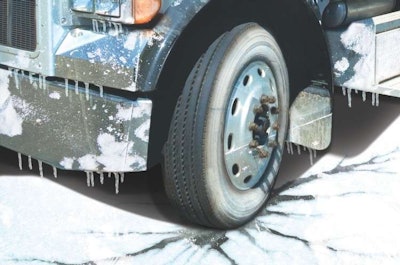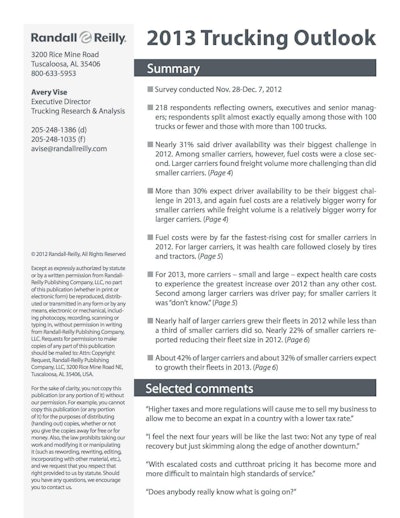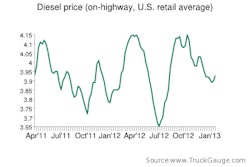
In Part 1 of our “On Thin Ice?” series, analysts and fleets discuss what they see happening in 2013 as far as the economy and freight are concerned and any roadblocks they see looming. Part 2 covers the impact regulations may have on trucking and surviving a tough environment in 2013 — see it here – and Part 3 will cover risk factors to watch for in 2013. See it Friday.
Analysts see tighter capacity making 2013 a good year, but carriers aren’t so sure.
Which way are the fundamentals of the economy headed for 2013? Most analysts see them as modestly positive, but carriers aren’t necessarily on board with this view.
“I’m always optimistic, but our equipment is getting older, and we are wondering how we’re going to replace it with current rates and volume of freight we are able to haul,” says Erik Olson, president of Memphis, Tenn.-based MLG Logistics.
“As our economy continues to drag along, I feel things will remain the same,” says Darrel Wilson, president of Strafford, Mo.-based Wil-Trans.
A decent year for freight?
“Absent an all-out recession, we should have continued recovery in housing and autos in 2013,” ATA Chief Economist Bob Costello says. “Those are the strengths of the U.S. economy, and they tend to be the early birds of better economic times.” Due to pent-up consumer and business investment demand, Costello thinks the economy could be pretty robust in 2014 and 2015.
While Costello’s medium-term outlook is optimistic compared to other analysts, he’s not alone in suggesting that 2013 will be a good year for the economy.
 Want a downloadable PDF of survey results, comments from the research and quick summation for reference or to handout to co-workers? Click the photo above — or click here.
Want a downloadable PDF of survey results, comments from the research and quick summation for reference or to handout to co-workers? Click the photo above — or click here.“It’s awfully hard to read at this point, because there’s so much uncertainty in the United States and the world,” says John Larkin, managing director at Stifel Nicolaus and head of the firm’s transportation and logistics research group. “But if you assume 1.5 percent to 2 percent growth in economy and freight, I think 2013 will be respectable. You will have a bit more freight and reduced capacity, especially as the hours-of-service rules kick in midyear.” The outlook is even brighter if Washington strikes a deal on the fiscal cliff that inspires consumer and business confidence, Larkin says.
“The economy looks better than we thought,” says Noël Perry, managing director for FTR Consulting Group and principal of transportation consulting firm Transport Fundamentals. Economic strengths include automobile sales in the range of 15 million annually – a figure consistent with 3 percent GDP growth, Perry says.
Also, the housing market is on its way to a recovery, and unemployment is at 7.7 percent rather than the 9 percent most people would have expected at this point. “For the last six months, the economic indicators have been mixed,” he says. “Nine months ago, they were more bad than good. Now they are more good than bad. This is not a synchronized recovery.”
And there’s another economic strength courtesy of Mother Nature’s wrath. “We haven’t factored in yet the measurably positive impact of Hurricane Sandy,” says Perry, noting that following Hurricane Katrina, there was a huge surge in trucking activity that clearly was attributable to the storm.
Costello also sees benefits from Sandy. “We could see some nice rebuilding in the Northeast and Mid-Atlantic, and that could help with flatbed volumes,” he says. Another plus for flatbed is that housing starts are helping to offset drops in steel production.
Donald Broughton is less optimistic about the prospects for freight demand in 2013. “If current freight trends continue, it may be time to use the ‘R’ word,” said Broughton, chief market strategist and senior transportation equity analyst for investment bank Avondale Partners, speaking at last month’s CCJ Fall Symposium in Scottsdale, Ariz.
Broughton cautions trucking companies against focusing too much on GDP numbers as an indicator of business conditions. While the most recent GDP report showed 2.7 percent growth – which was stronger than expected – it’s important to note that business inventories are included in the GDP calculation. “We get a false positive because although inventories are up, retail sales are slower,” he says. “I bet most of you that took even a nanosecond to look at that report thought it sure doesn’t feel like we had 2.7 percent growth.”
Every freight indicator is weakening, Broughton says. Domestic truck tonnage was growing at less than 1 percent year over year, and now it is contracting. Meanwhile, air freight already is contracting domestically and in the transatlantic and transpacific markets. Rail carloadings are flat to down depending on the commodity group, and international container volume is contracting.
“We are seeing a softening of the economy and presently don’t see the projected opportunities for 2013 that we saw in 2012,” says Gary Hanke, president of Louisville, Ky.-based Pegasus Transportation.
“Customers already smell blood in the water on pricing due to slack demand,” says Steve Gordon, chief operating officer of Pacific, Wash.-based Gordon Trucking. “It will be especially tough for smaller fleets to reinvest at the current level of return. We’re expecting a nasty start to 2013.”












